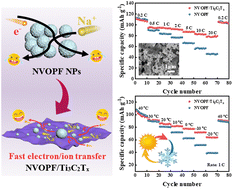Conductive Ti3C2Tx networks to optimize Na3V2O2(PO4)2F cathodes for improved rate capability and low-temperature operation†
Abstract
Na3V2O2(PO4)2F (NVOPF) is gaining attention as a high-energy cathode candidate for sodium-ion batteries owing to its wide operating voltage, high energy density and excellent thermal stability. However, its intrinsic poor electrical conductivity results in its current sodium-storage performance being far below expectations. Herein, two-dimensional Ti3C2Tx MXene nanosheets with excellent electrical conductivity are introduced to construct an interconnected conductive framework to tightly encapsulate NVOPF nanoparticles. The Ti3C2Tx nanosheets ensure superior electronic contacts, along with inhibiting the agglomeration of NVOPF nanoparticles, thus accelerating electron and ion transfer during sodium-ion de/intercalation and maximizing the storage capacity. As a result, the optimized NVOPF/Ti3C2Tx cathode exhibits high rate capabilities (111 mA h g−1 at 0.2 C and 78 mA h g−1 at 20 C), with an impressively high capacity retention of 74.8% over a wide temperature range (from −20 to 20 °C). Additionally, the assembled sodium-ion full cell provides a highly reversible capacity of 116 mA h g−1 at 1 C, with a capacity retention of 67.2% after 100 cycles. These inspiring results provide new insights for improving the charge-transfer kinetics of the NVOPF cathode and this methodology may be extended to other cathode materials.



 Please wait while we load your content...
Please wait while we load your content...